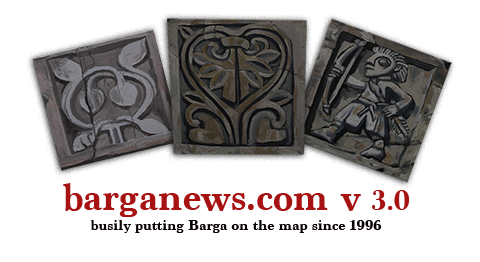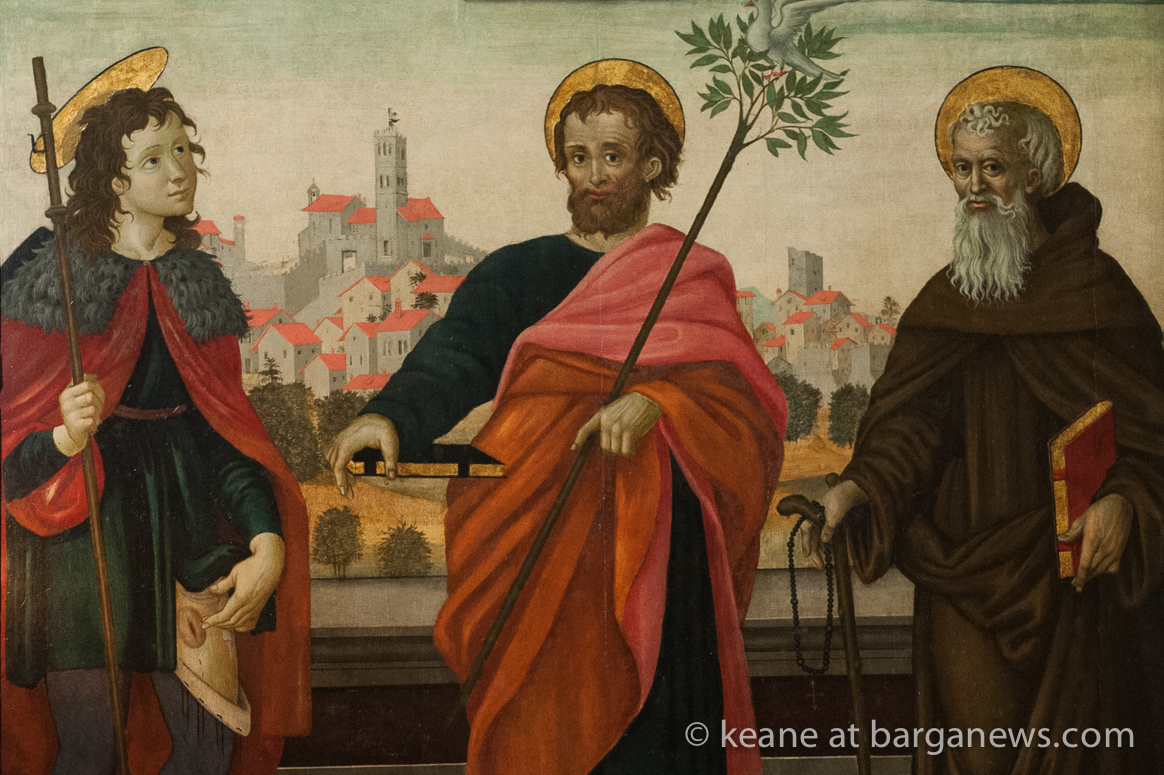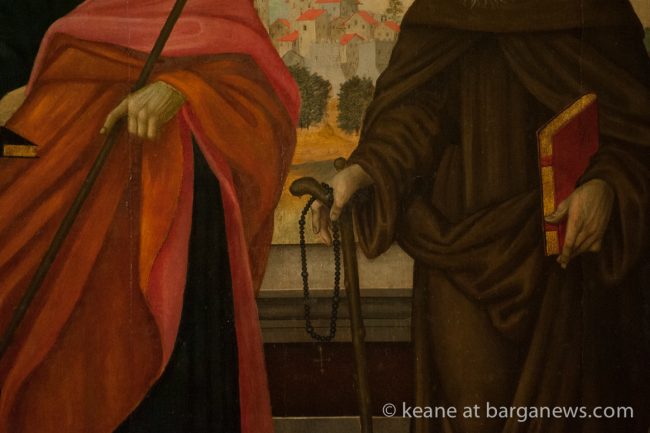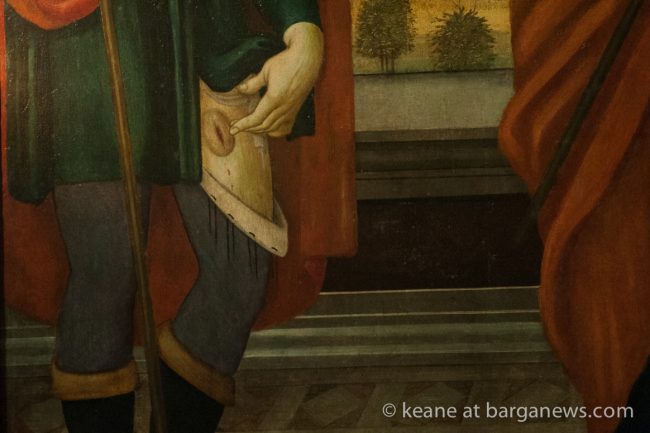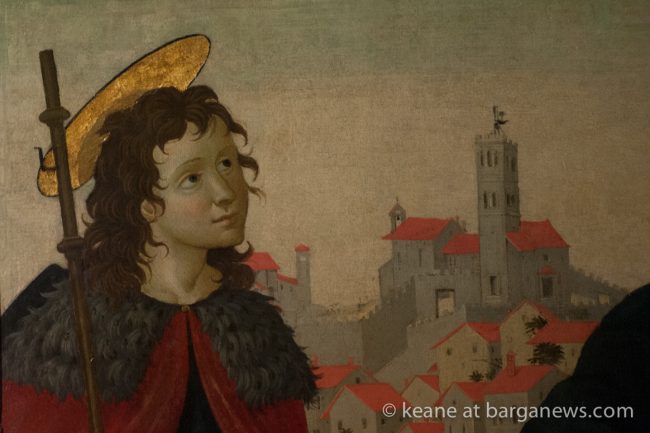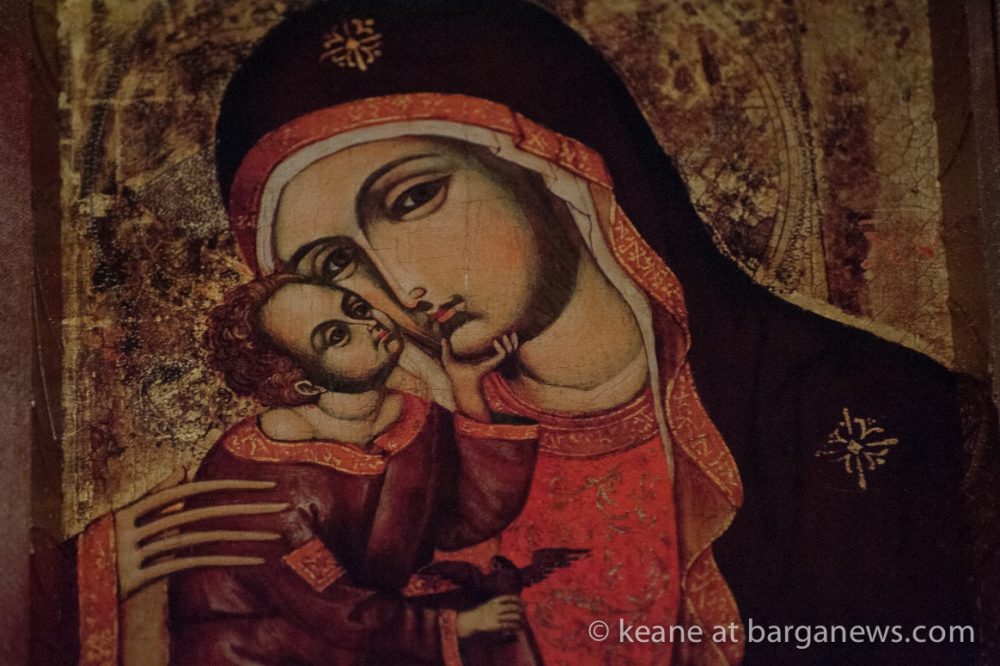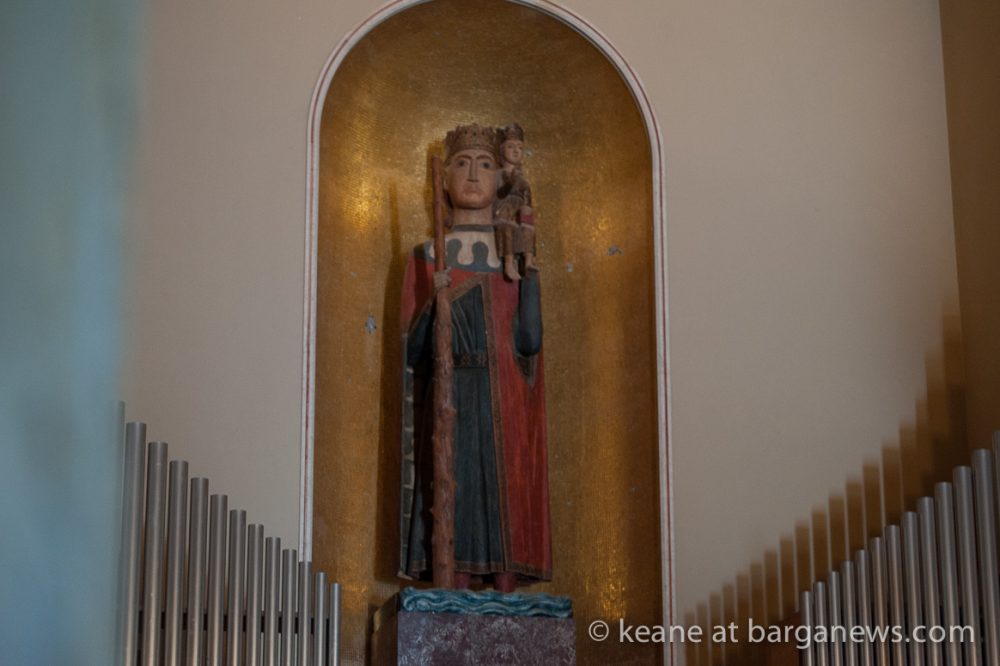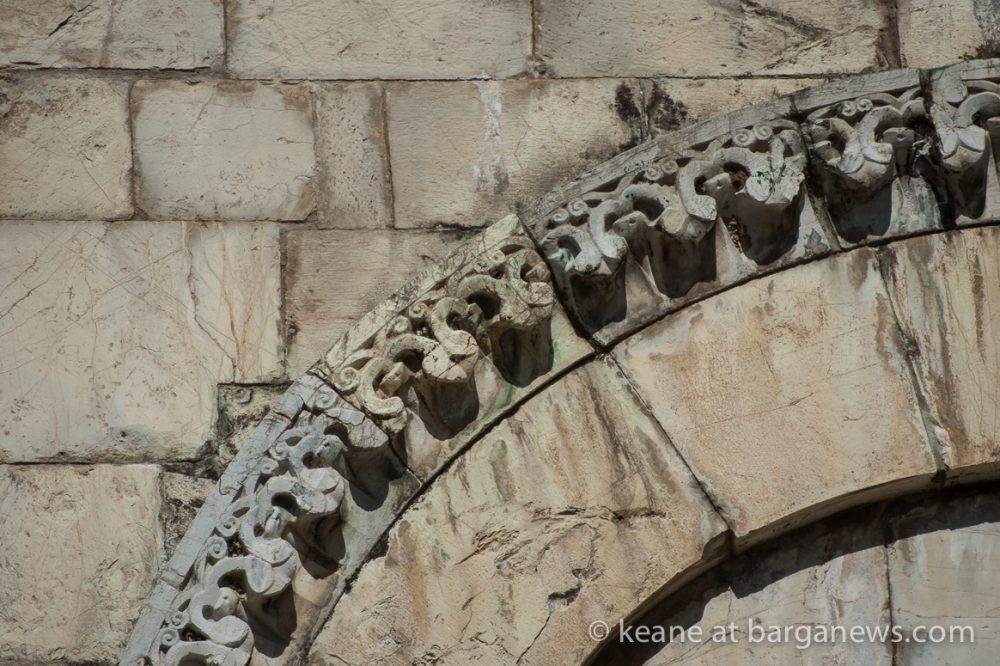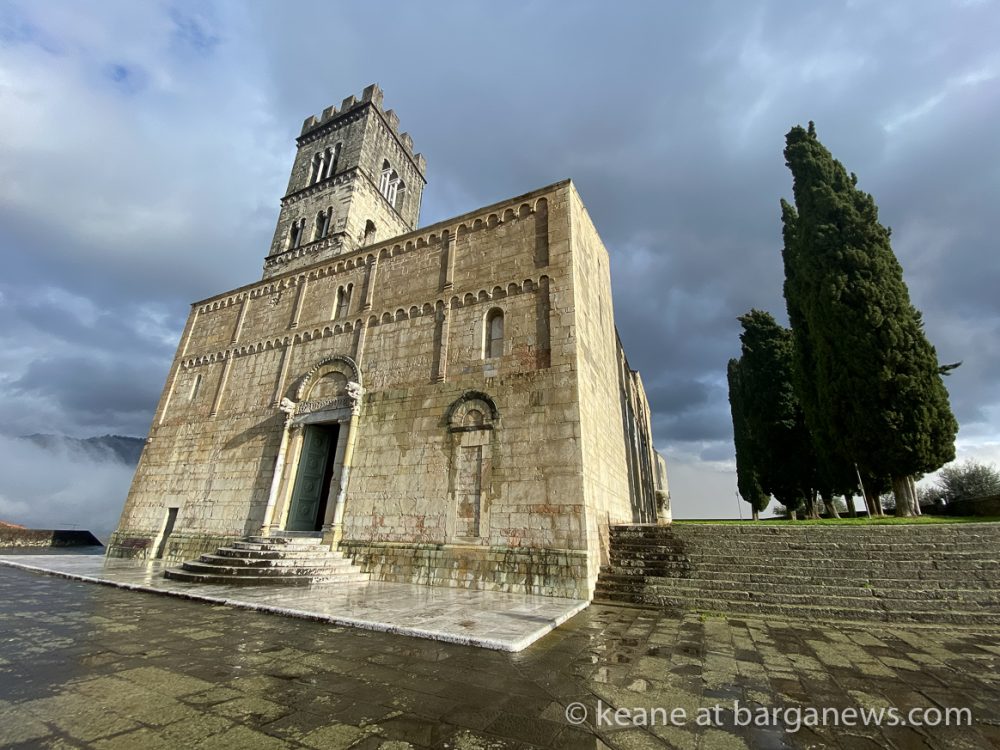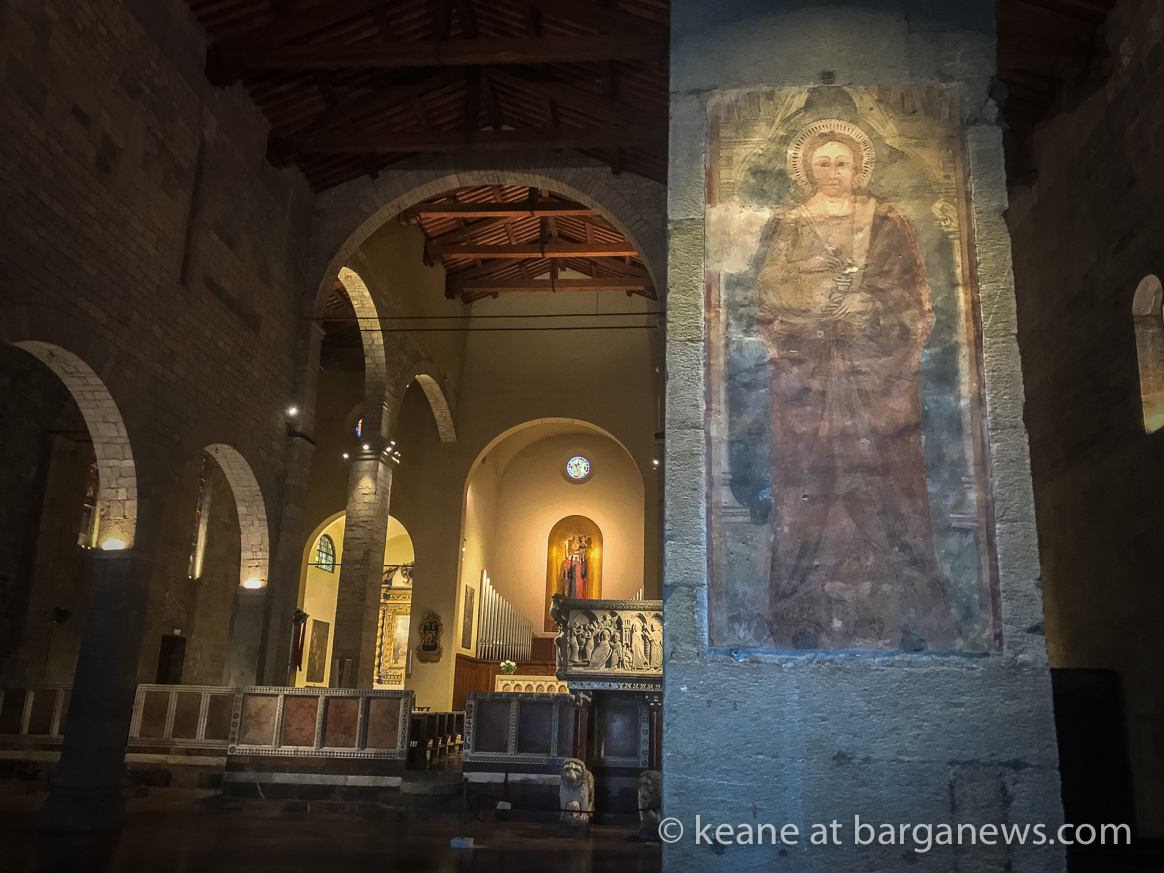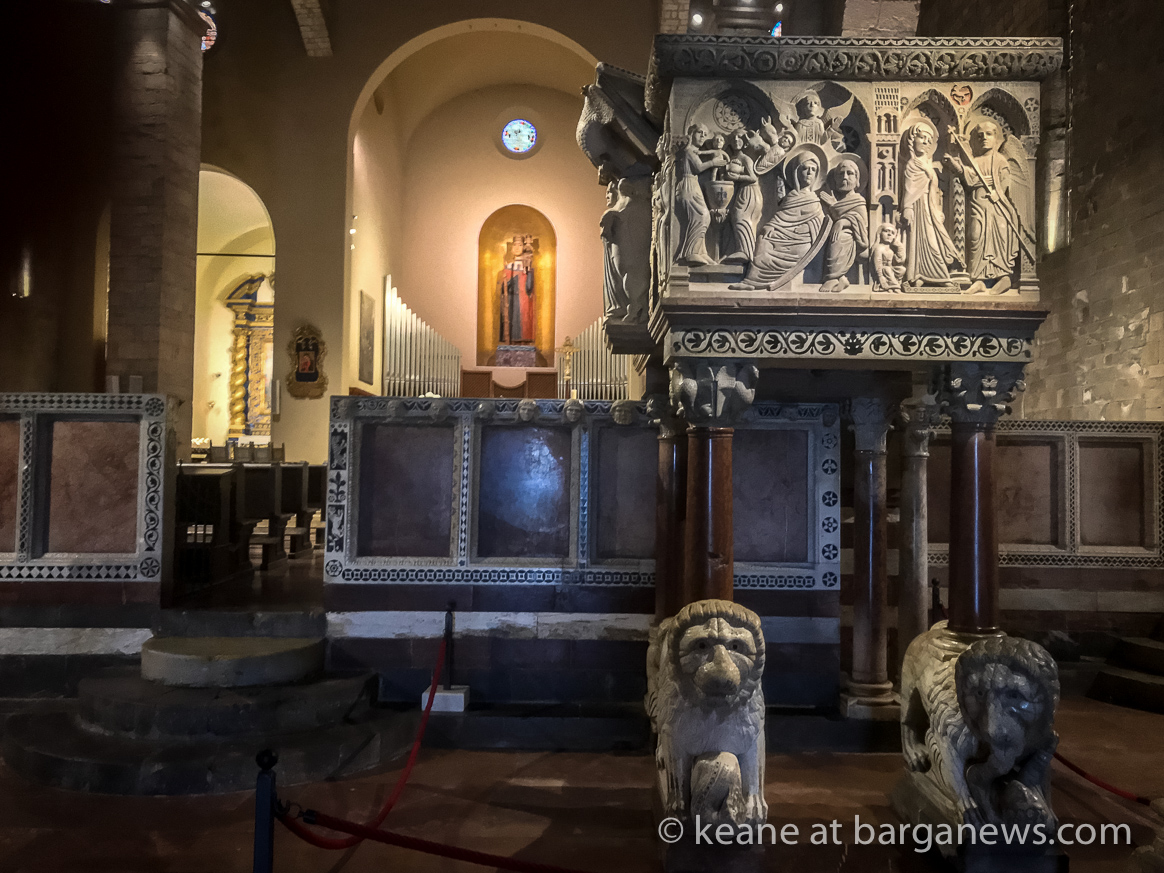It is well worth the effort to climb up the steep steps to the Aringo. This large open space, with its magnificent view at the highest point of the Barga hill (also known as the Romeccio hill), is the place where people gathered in the past to govern and to administer justice protected by its strong impregnable fortifications.
Here also is the site of the Duomo, the cathedral of Barga. This imposing structure, now a national monument, has dominated the territory of Barga and the Valley of the Serchio for over a thousand years.
If you are going up to the Aringo for the first time, either from Via del Pretorio or up the steps from Via della Speranza, you will find it difficult to decide whether to enter the Duomo directly, or to stop and admire the panorama which nature has so generously provided.
If you choose the latter you will see, on the one side, the line of the Apuan Alps and the Valley of the Serchio and on the other, behind the Duomo, the Appenine mountains of Tuscany and Emilia-Romagna whose steep slopes descend all the way down to Barga. But no description of this spectacular landscape is really adequate. You must see what has been the inspiration of poets and painters with your own eyes and your own feelings. It is always beautiful – by day in the sun or at night with the stars; in spring, summer, autumn or winter, when the scene changes with the continuous changes of colour with the seasons, or at sunset when the clouds in the background are tinged red, or on the 10th and 11th of November and the 30th and 31st of January, when there is the illusion of the double sunset. (article and many images here)
On these particular days, the rays of the sun create an optical illusion as they drop behind Monte Forato. They seem to reverse back onto the landscape giving an unreal aspect to the travertine facade of the cathedral and to its carved figures. And there is another illusion, also unique, to be seen from the Aringo. If you look across at the group of mountains which include Monte Forato and the Pania you find that across the horizon their profiles seem to form the outline of a giant who has been wounded and who is lying down on the bare earth. This configuration is known as the Dead Man and seems to be an offering by the Sculptor of the Universe to those on the Aringo who are straining their eyes to the uttermost limit to take in this astonishing scene.
From the back of the Duomo, the view is perhaps less spectacular, but even here nature has been generous. In the background, the crests of the Appenine mountains stand out against the sky, and from here you can see the mountains tops of the Romecchio, the Omo, the Giovo, and the Rondinaio which mark the border between Tuscany and Emilia-Romagna.
The steep slopes of these mountains, which descend as far as Barga, form a large number of small valleys and streams whose waters flow into the Serchio River. There are very few villages, or even houses in these areas and particularly in winter, when the snow is on the ground, or at night, when there are only a few lights here and there, you get the impression of an immense primitive landscape.
Turning now to the Duomo, you will experience, on the inside, an equal sensation of grandness and of natural beauty. The first construction was begun in the 10th Century, but this was followed by numerous additions, enlargements, restructurings and reconstructions right up until the first half of the 20th Century. The sum total of this work has created the magnificent cathedral that we see today and although wars and earthquakes have often threatened to destroy it, the people of Barga, with faith and good will, have always restored it and made it stronger and more beautiful. Throughout its history the voice of its bells has resounded from the bell tower across the valley and beyond.
During one of the restoration periods between 1927-1939, a plaque was mounted above the door leading to the bell tower, with the following inscription by Giovanni Pascoli:
“AT A TIME BEFORE THE YEAR 1000, WHEN THE PEOPLE OF BARGA WERE POOR AND LIVING ON ROAST CHESTNUTS THEY BUILT A DUOMO SAYING: IN MY HOUSE I HAVE TO JUMP FROM ONE BEAM TO ANOTHER – WHAT FREEDOM! BUT THE DUOMO MUST BE GRAND, AND MUST HAVE THE MOST BEAUTIFUL MARBLE PULPIT EVER SEEN SAYING: WHAT IS MINE IS SMALL, WHAT IS OURS IS GRAND!”.
The other important figures in this restoration were Monsignor Lino Lombardi and Morando Stefani, the “Workman” of the Duomo and Mayor of Barga.
As soon as you have crossed the threshold you will be struck by the huge 13th Century wooden statue of St. Christopher, the Christ Bearer, who is the patron saint of Barga and of automobile drivers. The cathedral is dedicated to him and from his niche of gold behind the high altar in the central choir, he seems to be reassuring the visitor that his strength is sufficient to calm the fears of all those who place their trust in him.
In the chapel to the left, at the centre of the Baroque altar, there is a lovely painting by an unknown artist, datable to around 1500, which besides depicting St. Joseph, St. Rocco and St. Anthony, shows Barga as it was in the 16th Century with its cathedral bell tower and battlements.
Inserted in the painting there is a 13th Century painted panel representing the Madonna del Mulino (Our Lady of the Mill), also by an unknown artist.
On the right hand walls of this chapel there is a 14th Century panel painting of the suffering Christ. The artists is unknown although Federico Zeri assigns it to a lesser known ‘Barga Master’ who was under the influence of the Emilian school.
The chapel on the right, known as the Santissimo Sacramento, is richly decorated with works in the style of the della Robbia brothers, but not always attributable to them. The unglazed altar piece depicting the Mother and Child with St. Rocco and St. Sebastian, is badly damaged from the time it was situated outdoors in the cloister of the monastery of St. Francis.
The Child in fact is missing as are several figures on the predella and there are obvious signs of extensive restoration.
On the side walls of this chapel two other works are displayed. On the left is the Ciborium of the Holy Oil by Andrea della Robbia and on the right is a small altar piece representing the Nativity.
The 13th Century marble pulpit is attributed to the Como school of Guido Bigarelli, and is the most precious work of art inside the Duomo. The symbolism of its sculpted figures is quite complex. In the section on the right is the figure of the prophet Isaiah. In the front there is a representation of the Annunciation and the Birth of Christ with an inscription in Latin which explains the symbolism. In the left section the Adoration of the Magi is depicted, but is blocked by a group of figures representing the four Evangelists. The human figure represents Mathew, the lion, Mark, the ox, Luke and the eagle, John.
The other human figure on the left has been interpreted in different ways. Some identify it as Joseph, others as Moses and others still, as Aronne, the first priest chosen by God. The two lions at the base of the columns symbolise the triumph of Christianity over evil and heresy. The lion on the left has a serpent (evil) between its legs and the one on the right holds a man (heresy) who is stroking the lion with one hand while stabbing it with the other.
Further treasures to be found in the Duomo are several other Della Robbian works, various paintings, stained glass windows and a large modern organ. Indeed this is a place no-one can ignore who sets foot in this historic town, a town which for its history, its art and its culture can be considered the pearl of the Serchio Valley.
Il Duomo di Barga, dedicato a San Cristoforo, sorge sulla
sommità della rocca che domina la cittadina e buona parte
della valle del Serchio. Si tratta di una notevole realizzazione,
tipica dell’architettura romanica, che ha vissuto
differenti fasi di costruzione e di ammodernamento nel
corso dei secoli.
La piccola chiesa castellana fondata tra X e XI secolo fu ampliata
nel XII, quando venne eretta una struttura a pianta
basilicale; la sua facciata è composta da blocchi squadrati
di una pietra calcarea che acquista tonalità cromatiche
e sfumature differenti a seconda dell’intensità della sua
esposizione alla luce del sole.
Sul portale laterale rivolto a Nord è uno splendido architrave
decorato a bassorilievo attribuito a Biduino, artista
operante in lucchesia nel XII sec.
L’interno della chiesa è composto da tre navate sostenute
da pilastri ed è diviso in due parti da massicci plutei duecenteschi
decorati. A fi anco del pluteo di destra è il celebre
ambone risalente alla seconda metà del XII secolo attribuito
a Guido Bigarelli, detto Guido da Como, mentre dal
semicerchio dell’abside troneggia la mole policroma del
San Cristoforo ligneo, alto 3,60 metri.
Nelle due cappelle laterali e nelle navate laterali si conservano
inoltre altre opere d’arte come la tela col San Cristoforo
di Nicolao Landucci (XIX sec.) o le maioliche robbiane
nella cappella del Santissimo Sacramento.
Dedicated to St. Christopher, Barga’s cathedral stands on the
top of the fortress that dominates the town and most of the
Serchio valley. It is a remarkable building typical of Romanesque
architecture, which has undergone different stages of
building and modernisation over the centuries.
The small castle church founded between the 10th and 11th
century was extended in the 12th century, when a basilican
plan building was erected; its facade is made up of square
blocks of a limestone that acquires different tones and shades
of colour depending on the intensity and its exposure to sunlight.
On the north-facing side door, there is a superb lintel decorated
with a bas-relief, attributed to the artist, Biduino working
in Lucca on 12th century.
The interior of the church consists of a nave and two aisles
supported by pillars. It is split in two by 13th-century ornate
solid pluteuses. Next to the right-hand pluteus, there’s the famous
pulpit dating back to the second half of the 12th century
attributed to Guido Bigarelli, known as Guido da Como,
whereas the great multicoloured wooden statue of St. Christopher
dominates from the semi-circle of the apse, standing
3.5 metres high.
Other works of art are also housed in the two side chapels
and aisles, such as the canvas with St. Christopher by Nicolao
Landucci (19th century) or the Della Robbia tiles in the
chapel of Santissimo Sacramento.
